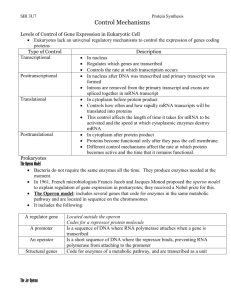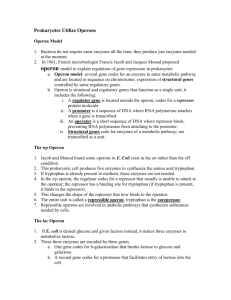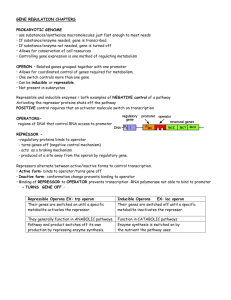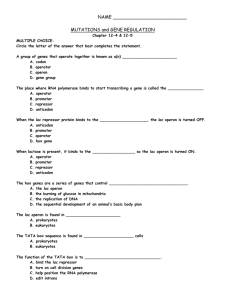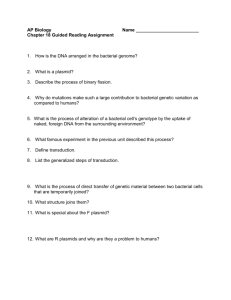The lac Operon - mr-youssef-mci
advertisement
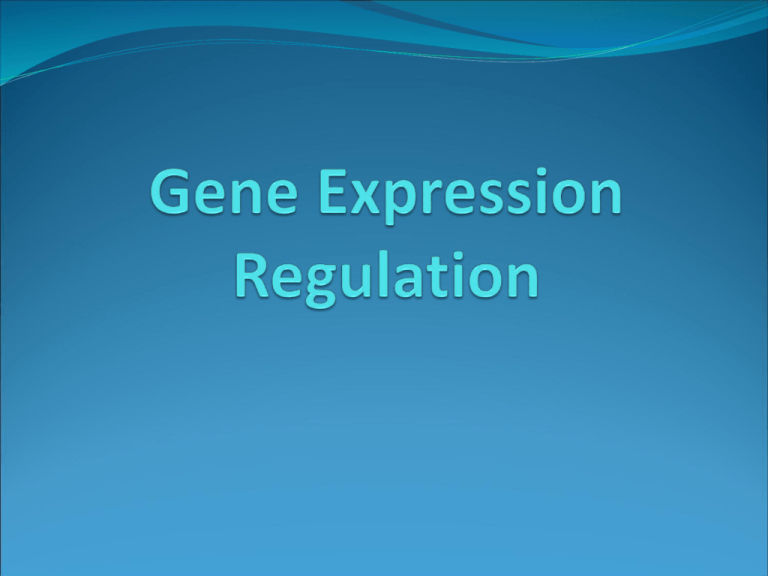
Control Mechanisms There are 42 000 genes that code for proteins in humans However, not all proteins are required at all times. E.g. Insulin is only required in a cell when glucose levels are high. It would be inefficient and wasteful for a cell to transcribe, translate the insulin gene when glucose levels are low Regulation is therefore vital to an organism’s survival Regulation – the turning on or off of specific genes depending on the requirements of an organism Why Turn Genes On and Off? Cell Specialization each cell of a multicellular eukaryote expresses only a small fraction of its genes Development different genes needed at different points in life cycle of an organism afterwards need to be turned off permanently Responding to organism’s needs cells of multicellular organisms must continually turn certain genes on & off in response to signals from their external & internal environment Signal NUCLEUS Chromatin Chromatin modification: DNA unpacking involving histone acetylation and DNA demethlation DNA Gene available for transcription The control of gene expression can Gene Transcription RNA occur at any step in the pathway from gene to functional protein Exon Primary transcript Intron RNA processing Tail Cap mRNA in nucleus Transport to cytoplasm The focus of today’s lesson will be on the regulation of gene expression at the transcriptional level. CYTOPLASM mRNA in cytoplasm Degradation of mRNA Translation Polypetide Cleavage Chemical modification Transport to cellular destination Active protein Degradation of protein Degraded protein Figure 19.3 Gene Expression Gene expression for all genes falls into one of two categories. (prokaryotes and eukaryotes) constitutive expression – genes which are always turned on 1. 2. known as housekeeping genes induced expression – genes which are only turned on as needed lac Operon lac - lactose operon – several genes in a sequence all controlled by a single promoter (mainly in prokaryotes; some eukaryotes). It also includes an operator which is the “on” and “off” switch. promoter gene 1 operator gene 2 gene 3 lac Operon Cells mainly use glucose as a source of energy. The lac operon is only turned on when glucose is absent, but lactose is present. lac Operon Animation lac Operon Details Operon codes for 3 enzymes – found in E. coli 1. beta-galactosidase (lacZ gene) enzyme which breaks down lactose 2. permease (lacY gene) protein transporter which brings lactose into cell 3. transacetylase (lacA gene) adds acetyl group to galactose Repressor Protein repressor protein (lacI gene) transcribed by a different gene from the lac operon binds to the operator portion in the presence of glucose prevents RNA polymerase from transcribing genes when bound to operator Lactose is not needed as an energy source because glucose is present When do you want the repressor to bind / not bind to the operon? When lactose is absent: enzymes are not needed to metabolise lactose repressor binds to the operator to inhibit transcription Promoter Regulatory gene DNA mRNA Protein Operator lacl 5’ lacZ 3’ RNA polymerase No RNA made Active repressor (a) Lactose absent, repressor active, operon off. The lac repressor is innately active, and in the absence of lactose it switches off the operon by binding to the operator. Figure 18.22a When lactose is present: Lactose (or allactose) binds to the repressor protein lactose-repressor complex cannot bind to the operator transcription can proceed lac operon DNA lacl lacz 3’ mRNA 5’ lacA RNA polymerase mRNA 5' 5’ mRNA β-Galactosidase Protein Allolactose (inducer) lacY Permease Transacetylase Inactive repressor (b) Lactose present, repressor inactive, operon on. Allolactose, an isomer of lactose, derepresses the operon by inactivating the repressor. In this way, the enzymes for lactose utilization are induced. Figure 18.22b Effector Molecules Since lactose is the molecule that determines when the operon is turned on or off, it is known as an effector molecule. effector molecule – any molecule that can regulate the activity of a protein inducer – effector molecule that binds repressor protein to cause it to fall off operator Regulatory gene Promoter Operator DNA mRNA 5’ Protein lacl lacZ No RNA made 3’ RNA polymerase Active repressor (a) Lactose absent, repressor active, operon off. lac operon DNA lacl mRNA 5’ lacz lacY lacA RNA 3’ polymerase mRNA 5' 5’ mRNA Protein Allolactose (inducer) Inactive repressor (b) Lactose present, repressor inactive, operon on. trp Operon trp – tryptophan The genes of the trp operon are used to make the amino acid tryptophan. It is turned off when enough tryptophan is in the cell. Tryptophan is the effector molecule. trp Operon Operon codes for 5 genes – found in E. coli Five polypeptides combine to make three enzymes. each enzyme participates in a step to make tryptophan Repressor Protein repressor protein (trpR) transcribed as a different gene from trp operon binds to operator when tryptophan is present prevents RNA polymerase from transcribing genes when bound to operator When do you want the repressor to NOT bind to the trp operon? When tryptophan needs to be made: enzymes are required to make tryptophan repressor is NOT bound to operator transcription can proceed trp operon Promoter DNA Promoter Genes of operon trpD trpC trpE trpR trpB trpA Operator Regulatory gene mRNA 5’ RNA 3’ polymerase mRNA 5’ E Protein Inactive repressor D C B A Polypeptides that make up enzymes for tryptophan synthesis (a) Tryptophan absent, repressor inactive, operon on. RNA polymerase attaches to the DNA at the promoter and transcribes the operon’s genes. When cell has enough tryptophan: tryptophan binds to repressor repressor can now bind operator to prevent transcription DNA No RNA made mRNA RNA Polymerase Protein Active repressor Tryptophan (corepressor) (b) Tryptophan present, repressor active, operon off. As tryptophan accumulates, it inhibits its own production by activating the repressor protein. Effector Molecule Since tryptophan is the molecule that determines when the operon is turned on or off, it is known as an effector molecule. corepressor – effector molecule that binds repressor protein to cause it to bind to the operator DNA No RNA made mRNA Protein Active repressor Tryptophan (corepressor) (b) Tryptophan present, repressor active, operon off. trp operon Promoter DNA Promoter Genes of operon trpE trpD trpC Operator trpR 3’ mRNA 5’ Protein 5’ E Inactive repressor trpB trpA D C B A Polypeptides that make up enzymes for tryptophan synthesis (a) Tryptophan absent, repressor inactive, operon on. http://www.youtube.com/watch?v=VNokvF03aI http://www.youtube.com/watch?v=3S3ZOm leAj0 Classwork/Homework Section 5.5 Questions pg. 258 #1-6

